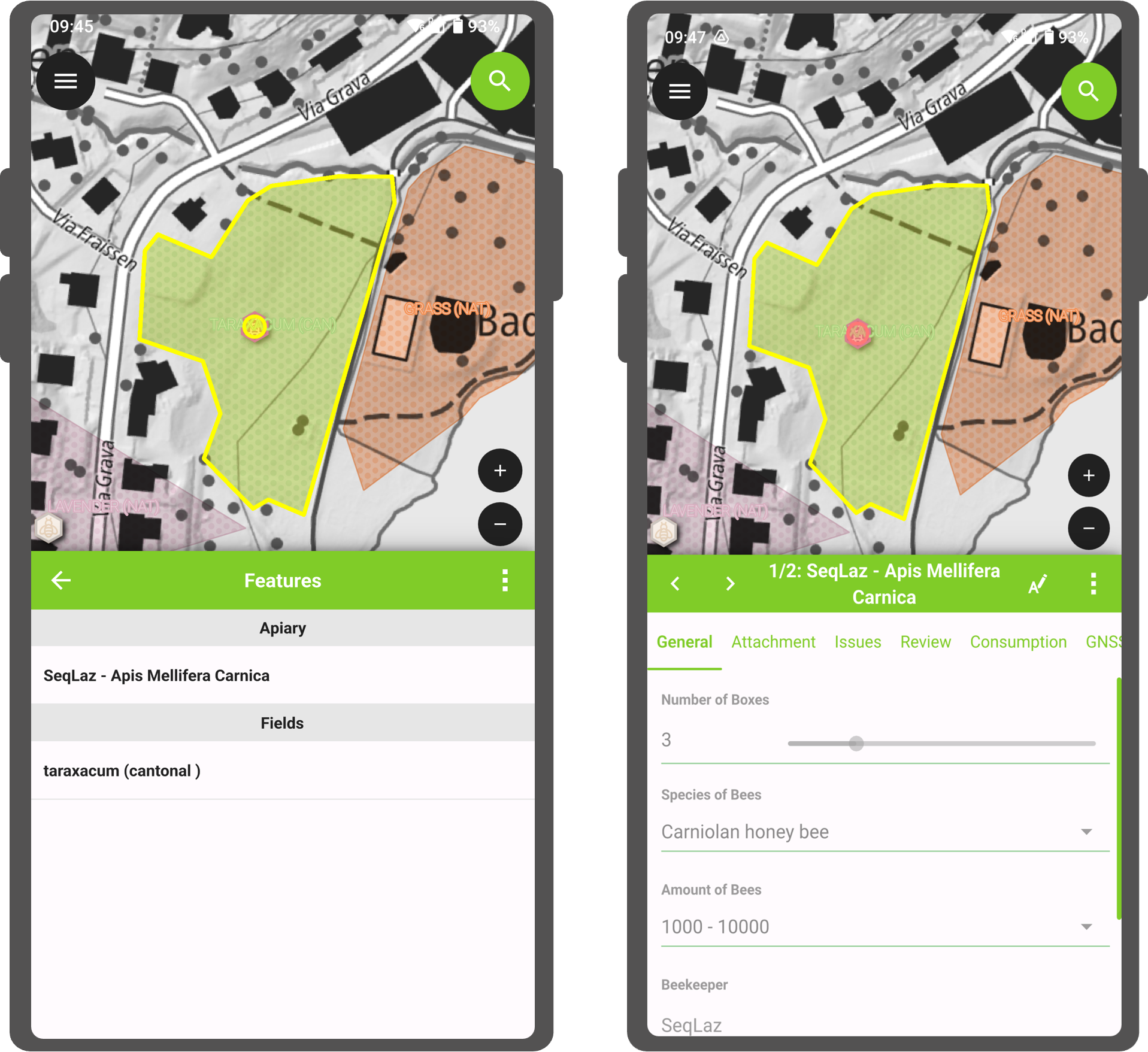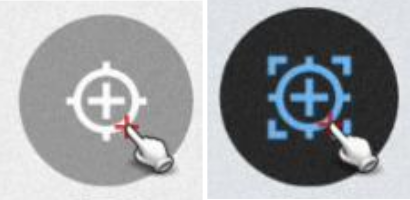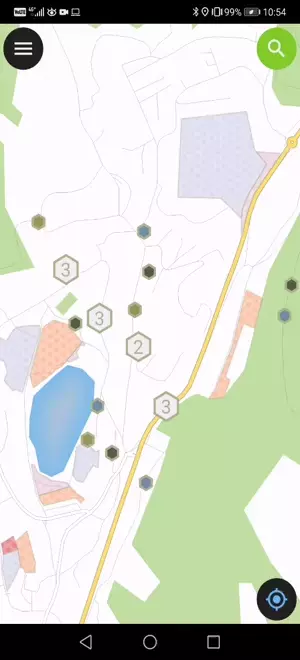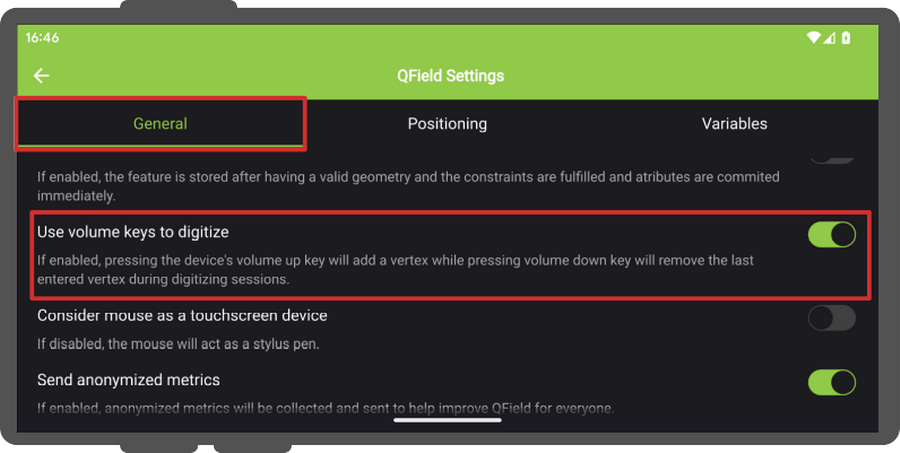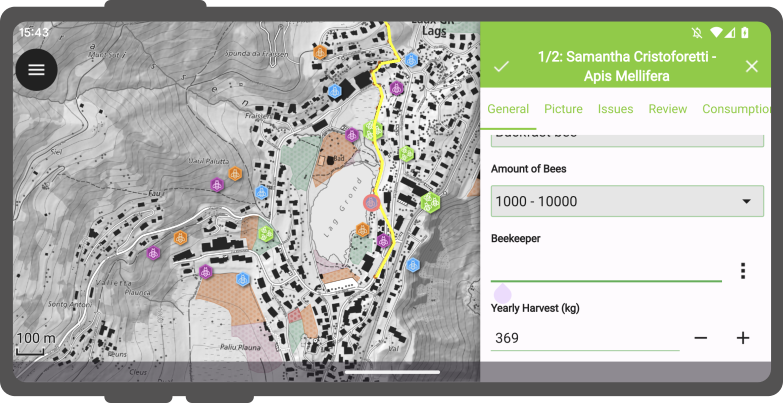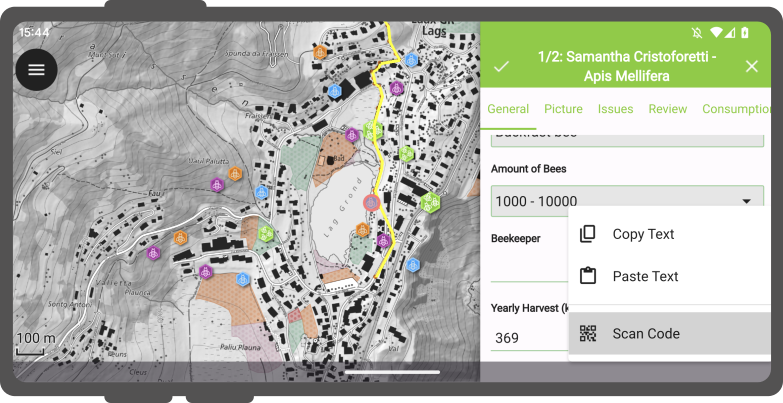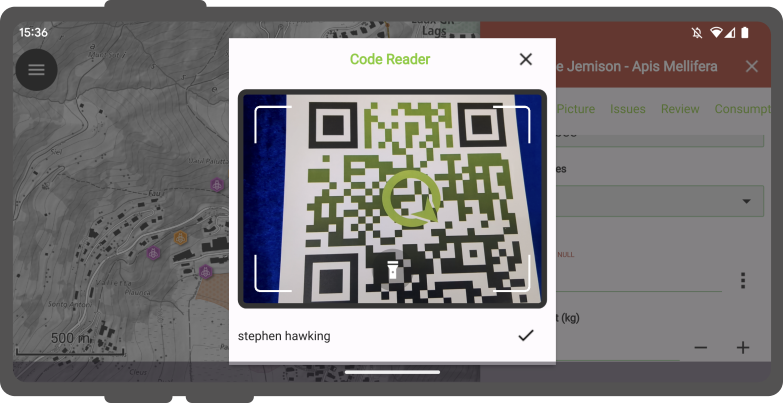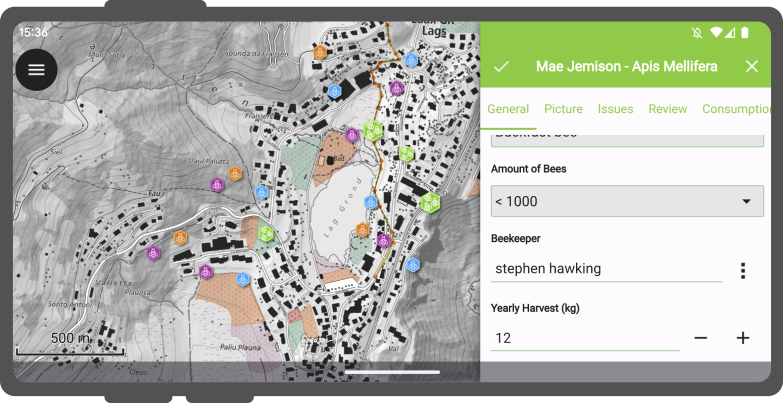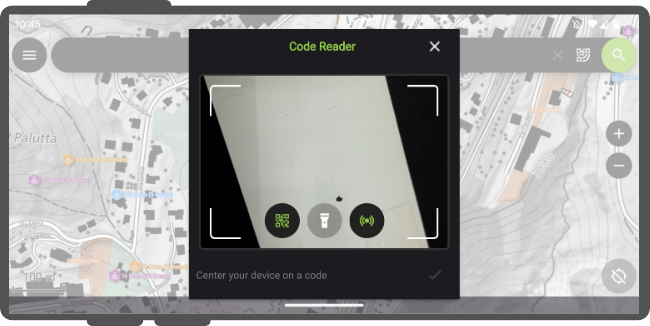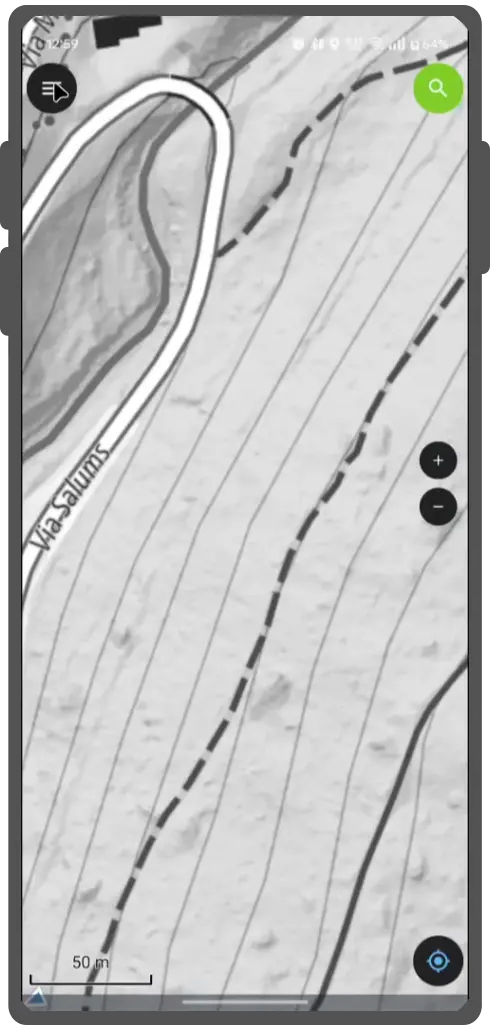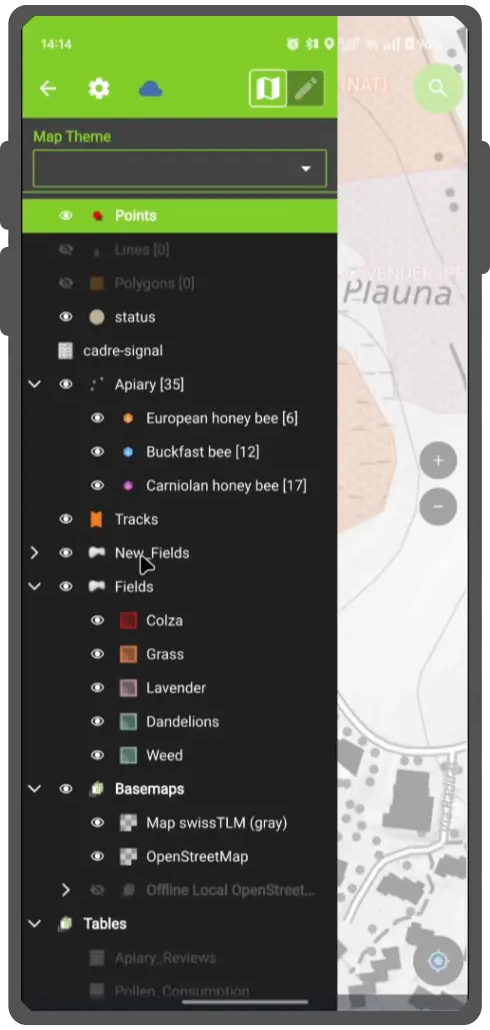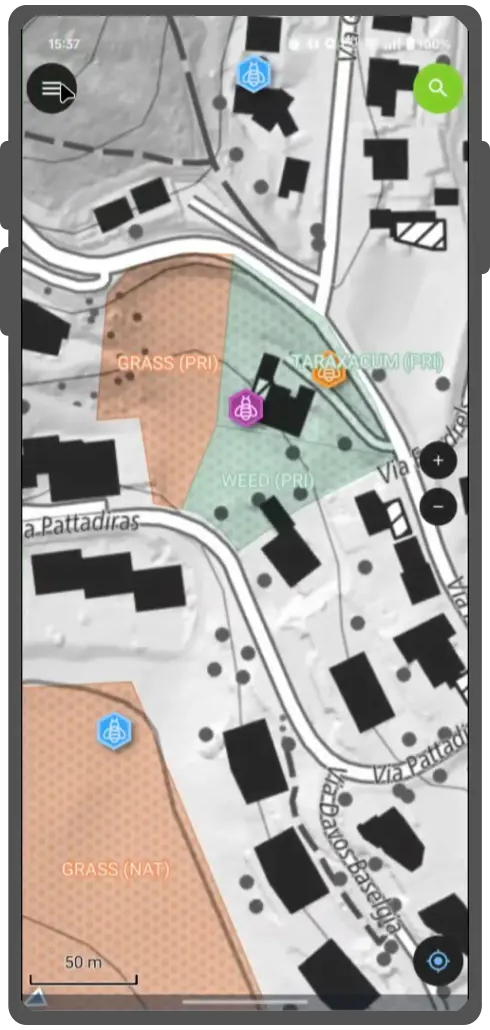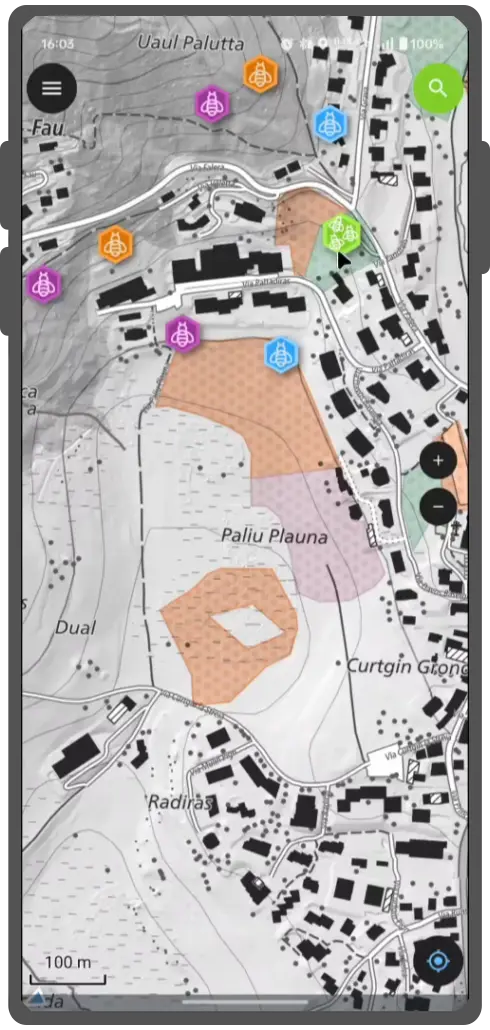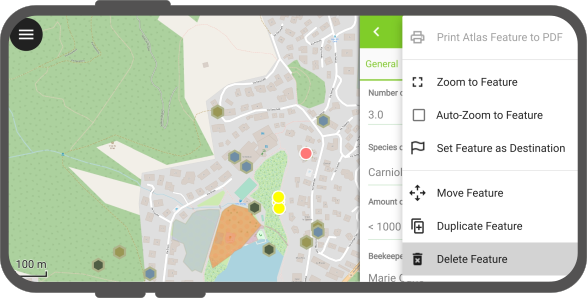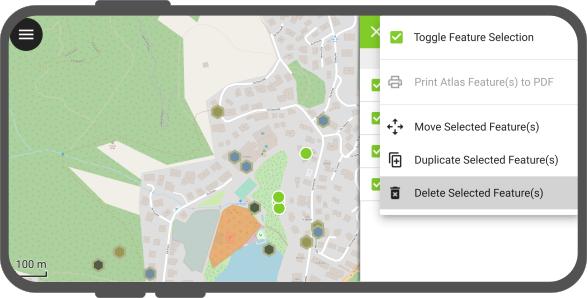Digitize and Edit¶
With QField you can digitize, edit and delete points, lines and polygons and their according attributes while being in the field. Similar to QGIS, QField has two modes. The browse mode and the digitize mode.
Browse Mode¶
As the name suggests, while being in browse mode, you can view and select features within all identifiable layers in the project. It is also possible to edit attributes of existing features, by clicking on a feature of interest and opening its attribute table.
Digitize Mode¶
Terrain
To start digitizing new features, enable the Digitize mode by clicking on the pencil icon in the side "Dashboard" and selecting the layer within which you want to add new features. The current layer within which features are to be added is highlighted in green.
Tip
QField insures that digitized geometries will not have duplicate vertices and respects the geometry precision settings from the currently selected layer.
Ajouter des points¶
Workflow
- Navigate the crosshair in the center of the screen to the desired location
- Click the Green Plus (+) button at the lower right of the screen add a new point feature. (Optionable): You can use the lock to position button to force the crosshair to center on your location if you have enabled positioning.
- (Optionable): You can click the (x) button to cancel the current feature creation.
Ajouter des lignes ou des polygones¶
Worlflow
- Navigate the crosshair in the center of the screen to the desired start of the line or polygon
- Click the Plus (+) button at the lower right of the screen to add the first node.
- Adding more points to form you line or polygon by clicking the Plus (+) button each time you want to add a new node.
-
(Optionable) Click the Minus (-) button to remove the last added node.
-
Click on the Save button to finish your edition. You need to add at least 2 nodes for line features and 3 for polygons.
-
(Optionable): You can click the (x) button to cancel the current feature creation.
Additional Editing Settings¶
There are other more advanced settings, which you can enable to make your data collection more efficient:
- Use volume keys to digitize: If you want to avoid to have to tap on your device for every note you can enable this option to add and remove nodes using the volume keys. Note: This feature is only available for Android Devices
- Allow finger tap on canvas to add vertices: If you want to use your finger to add notes as well rather than having to press the button the whole time.
Formulaire d'attributs¶
After digitizing a geometry, the attribute form will appear allowing you to edit attribute values for the newly added feature.
Note
You can hide the attribute form upon feature addition via a configuration option for a given layer via its properties dialog in QGIS.
Moreover, you have the option to digitize the form using the scanning QR and Barcode reader functionality available within the feature form's text edit widget.
Upon clicking the icon button with the three dots, a menu will be presented offering three distinct actions: "Copy", "Paste", and "Scan Code".
Opter pour l'action "Scanner le code" affichera le lecteur de code de QField, qui permet de le scanner pour le décoder.
Once the codes have been successfully scanned, users can validate their choice by clicking the checkmark (✔️) OK button. This action will populate the attribute with the decoded value, streamlining the digitization process.
De plus, le lecteur de code offre la possibilité de lire les balises de texte NFC.
Note
Both the QR code camera and the NFC text tag detector are enabled by default when you open the Code Reader. You have the flexibility to disable either of these features to ensure that your device's battery is not used unnecessarily by using hardware that you may not need at the moment.
Garder en mémoire les valeurs de l'attribut.¶
For quick collection of rather homogeneous datasets, it is crucial to not having to enter the same attribute values multiple times. The pins on the right of every attribute enable the last entered value option for each attribute individually so that the next time you will add a feature on the same layer, these attributes will be automatically pre-filled. It needs to be noted that this last entered value only applies when collecting new features not when editing existing ones, unless otherwise specified.
Édition de la géométrie¶
Terrain
To edit the geometry of pre-existing features, enable the Digitize mode by tapping on the pencil icon underneath the legend.
Once in digitize mode, a new Edit geometry button will appear in the title bar of an identified feature form. Clicking on the button will activate the geometry editing environment which offers four tools:
- Un outil d'édition de sommet;
- Un outil de découpage;
- Un outil de remodelage; et
- Un outil pour les anneaux.
Outil d'édition de sommet¶
The vertex editor allows you to move or delete pre-existing vertices as well as adding new vertices to geometries.
Outil de Découpage¶
The split tool allows you to split line and polygon geometries into two halves, one of which will become a new feature of its own.
Outil de remodelage¶
The reshape tool allows you to change line and polygon geometries by drawing shapes which will result in a reshaped line following the edge of the drawn shape or a polygon with the drawn shaped used to clip or expand the geometry.
Reshape eraser tool¶
The reshape eraser tool is designed to ease the removal of parts of a line or polygon geometry. The tool mimics eraser tools from 2D drawing programs and works best with a stylus.
Suppose you have a polygon representing a building footprint, but there's an unwanted protrusion. You can use the erase tool to precisely remove that portion of the polygon, ensuring accuracy in your geometry representation.
Outil anneau¶
The ring tool allows you to digitize rings (i.e. holes) into polygon geometries. Once a ring is created, QField will offer the possibility of filling the ring with a new feature.
Démonstration d'édition de géométries¶
Démonstration vidéo de quelques possibilités d'édition :
Fusionner des entités¶
QField allows you to merge features and their geometries into a single feature. To do so, identify two (or more) features on the map, select them in the features list and merge them by selecting the Merge Selected Features in the Menu (⁝) Button.
Pour exécuter la fusion dans QField, assurez-vous des conditions suivantes :
- Couche Vecteur en mode Edition :
-
La couche cible doit être en mode édition.
-
Géométrie Multi-Parties :
-
Assurez-vous que le type de géométrie de la couche est multi-ligne ou multi-polygone.
-
Capacités du fournisseur de données :
- Vérifiez que le fournisseur de données associé à la couche (de préférence GeoPackage) possède la capacité de :
- Modifier les géométries : possibilité d'apporter des modifications aux géométries existantes.
- Supprimer des entités : possibilité de supprimer des entités individuelles parmi l'ensemble de données.
Numérisation à main levée¶
The freehand digitizing mode allows you to "draw" lines and polygons using their stylus pen or mouse. The mode is available for line and polygon feature additions as well as the above-mentioned geometry editor's rings, split, and reshape tools.
The freehand digitizing mode is activated through a new toolbar button which appears when QField is set to editing mode and a stylus pen or a mouse is hovering the map canvas while a line or polygon vector is selected.
Édition Topologique¶
If topological editing is activated on the project in QGIS before exporting for QField, shared nodes of neighboring geometries are modified together when moving / deleting vertices and additional vertices are added to segments when a new node is added from neighboring geometries.
Multi-édition des attributs¶
QField allows you to select multiple features and edit their attributes all at once. In some cases, it can result in very efficient workflows. To do so, identify two (or more)features on the map, select them in the features list and merge them by selecting the Edit feature button in the list's title bar.
Supprimer des entités¶
Terrain
Deleting a feature is done by selecting the Delete feature action in the feature form's (⋮) menu.
QField also allows you to delete multiple features at a time. To do so, first identify the features by short tapping on the relevant parts of the map. Then activate the multi-selection mode by long pressing on one of the features you want to delete. When checkbox appears next to the feature names, select further features to delete (you can tap on the map to add more features too). Once done, select the "Delete Selected Feature(s): action in the features list (⋮) menu.
Accrochage¶
Préparation Ordinateur
Lors de la numérisation de nouvelles entités, les nouveaux points peuvent être accrochés aux géométries existantes.
All configuration can be done in Project > Snapping Settings
Types d'accrochage¶
It is possible to snap new points:
- uniquement aux sommets des géométries existantes
- uniquement aux segments des géométries existantes
- aux sommets et segments des géométries existantes
Accrochage à des couches¶
Il est possible d'accrocher à une seule ou plusieurs couches
Tolérance d'accrochage¶
La tolérance d'accrochage peut être spécifiée en unités de cartes ou en pixels
In almost any case, the units should be set to pixels. We made good experiences with a tolerance value of 20.
Snap to Common Angle¶
The Snap to Common Angle feature enhances the precision and efficiency of digitizing geometries by allowing to snap to predefined common angles: 10°, 15°, 30°, 45°, and 90°. This functionality is similar to the advanced digitizing tool in QGIS.
To activate Snap to Common Angle, open the geometry editor and tap on the Snap to Common Angle icon in the toolbar to bring up a menu of common angles. Choose the desired angle from the menu. Then, start digitizing your geometry or adding vertices, and the functionality will automatically align your input to the selected angle. QField will remember the angle relative to the last segment situation for consistent snapping behaviour during subsequent edits.
